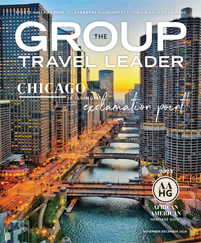Shrieking fans, hooves kicking up dirt, lassos flying through the air, the sound of the buzzer — rodeos elicit a one-of-a-kind excitement. Here are five of North America’s top rodeos where you and your group can pull out your cowboy boots and explore all this great sport has to offer.
Prescott Frontier Days
Prescott, Arizona
Prescott Frontier began on July 4, 1888, when a group of merchants and businessmen in Prescott, Arizona, held the first formal “cowboy tournament” in Forbing Park and awarded cash prizes. Today, it is a multiday event hosted over the Fourth of July that draws approximately 27,000 spectators and is known as the “World’s Oldest Rodeo.”
Visitors can catch one or more of eight thrilling performances that feature competitions in wild horse racing, steer wrestling, bareback riding, tie-down roping, breakaway roping, saddle bronc riding, team roping, barrel racing and bull riding.
“When you come to the World’s Oldest Rodeo, you’re seeing the top-performing cowboys from across the world,” said Ann Steward, the tourism and economic initiatives manager for the City of Prescott. “They’re skilled at what they do.”
Guests also have the chance to buy a variety of foods, from kettle corn to samosas, as well as souvenirs and Western art and crafts.
While in Prescott for the event, visitors are also encouraged to check out the area’s museums, such as Phippen, Sharlot Hall and the Museum of Indigenous People, as well as explore the outdoors at Watson Lake Park and Goldwater Lake.
“We’re a small town, so you can experience a lot in a little amount of time,” Steward said.
Cheyenne Frontier Days
Cheyenne, Wyoming
Though it started in 1897 as a one-day event featuring pony racing, bronco busting and steer roping to attract travelers during the 1890s depression, Cheyenne Frontier Days in Wyoming has grown to become the world’s largest outdoor rodeo and Western celebration, drawing approximately 250,000 people.
Held during the last full week of July, this 10-day festival hosts nail-biting competitions, including bareback riding, barrel racing, bull riding, tie-down and team roping, saddle bronc riding, steer wrestling, wild horse racing and breakaway roping.
“It’s professional sports at its best,” said Jim Walter, vice president and director of sales and marketing for Visit Cheyenne. “And the accessibility of rodeo athletes — a lot of them will sign autographs after they’ve competed.”
When not on the edge of their seats in the arena, attendees are met with an air show by the U.S. Air Force Thunderbirds, four parades, a carnival, performances by big-name musical artists, Western products and branded apparel for purchase and a host of food vendors.
“They try to bring a variety of the things you’d expect — fried dough, spiraled potatoes — and things you might not expect. There’s usually a wild-game booth of some sort there, too,” Walter said.
Another key part of the event is Indian Village, where individuals from the Northern Arapaho and Eastern Shoshone tribes share with visitors their Native American history and culture through dance, storytelling and music.
While in Cheyenne, visitors are also encouraged to explore the Wyoming State Museum and State Capitol, as well as Terry Bison Ranch, where they can view and feed bison.
“This is your opportunity to get up close and personal with a bison in a safe, controlled manner and have that experience,” Walter said.
While Cheyenne Frontier Days offers groups packages, Visit Cheyenne also boasts a $25/person Legendary Pass that provides discounts for attractions in the area, including Terry Bison Ranch.
Greeley Stampede
Greeley, Colorado
To honor its potato farmers, the community of Greeley, Colorado, hosted Greeley Spud Rodeo in 1922, which drew an estimated 2,500 people to a day of pie eating, horse racing, bucking bronc riding, fancy roping and more. The event, including its name and offerings, has changed over the years to become an internationally acclaimed festival that attracts more than 250,000 people.
Held around the Fourth of July, this 10–14-day festival hosts top athletes from all over the world who compete in bareback bronc riding, steer wrestling, team roping, saddle bronc riding, tie-down roping, breakaway roping, barrel racing and bull riding competitions.
“We have the best contestants coming, and I think we have the best venue, as well,” said Justin Watada, general manager of Greeley Stampede. “It holds up to 9,000 people for the rodeo, and there are great views from all angles.”
Entertainment runs the gamut at Greeley Stampede. The event includes multiple arena concerts, a demolition derby, daily parades, vendors selling everything from cowboy hats to hot tubs, a carnival and a variety of foods.
“If you’re a die-hard rodeo person, and you know that that’s a top 10 bull rider on the bull, or if you’re a casual fan who just wants to bring your family to the rodeo, we try to make sure it’s top-notch but also a great experience for that family coming out,” Watada said.
A favorite attraction among many is the Western Art Show, which showcases over 200 Western paintings and sculptures by artists from all over the world.
Depending on which festival competitions and attractions groups want to see, Greeley Stampede can customize packages to best meet their needs. Plus, the organization, along with others in the area, partners with Visit Greeley to offer packages that include visits to additional attractions in the city, such as the Colorado Model Railroad Museum.
Reno Rodeo
Reno, Nevada
The Reno Rodeo can be traced back to 1919 when the Commercial Club, a precursor of the area’s chamber of commerce, hosted a community event full of rodeo competitions to draw tourists and recognize the rodeo athletes of that time. Today, Reno Rodeo is an activity-packed, 11-day event held in June that draws more than 140,000 people each year.
Visitors enjoy watching nine days of fierce competition in team roping, steer wrestling, bareback and saddle bronc riding, tie-down roping, barrel racing, breakaway roping and bull riding.
“The talent of the riders is just unbelievable,” said Charles Harris, president and CEO of Visit Reno Tahoe. “There’s electricity in the air while you’re there.”
While the rodeo competitions draw visitors from far and wide, the event is overflowing with other attractions, including a kick-off concert, a parade, steer decorating, a carnival, a golf tournament, and several vendors selling a variety of delicious food and apparel.
“There’s lots of shopping, lots of vendors — people come out, and they have a good time, whether you’re drinking beer, getting food. There is all sorts of fun stuff that goes on out there,” Harris said.
Groups attending Reno Rodeo can receive discounted tickets for Monday through Wednesday performances in certain grandstands. Plus, while they aren’t cheering on athletes or chowing down on carnival food, they can explore the surrounding area and check out one of the many gaming locations, historic mine tours in Virginia City and water sports on Lake Tahoe.
“When you have that opportunity to enjoy the outdoors and do things during the day and the rodeo in the evening, there’s nothing better,” Harris said.
Calgary Stampede
Calgary, Alberta
A vision of Guy Weadick of Rochester, New York, who visited Calgary, Alberta, with a traveling Western showcase and saw its potential for a frontier days and cowboy championship contest, the first Calgary Stampede was held in 1912 and drew 80,000 people to its parade and rodeo events.
While paused for a few years due to economic downturn and later combined with Calgary’s Exhibition, an event that celebrated Western agriculture, today’s Calgary Stampede attracts more than 1.2 million people.
This 10-day event draws the world’s toughest athletes to compete in bareback riding, barrel racing, bull riding, tie-down roping, steer wrestling and saddle bronc riding.
“Since 1923, we’ve also offered chuckwagon racing, so we’re coming up on 100 years of that, which is a very unique sport,” said Kristina Barnes, Calgary Stampede’s manager of agriculture and Western events.
The Stampede also brims with live music offered at four venues; the Bell Grandstand Show, which features amazing stunts and pyrotechnics; a carnival; freestyle motocross; agriculture showcases; Western shopping; fine dining and carnival food; and much more.
A unique aspect of the event is Elbow River Camp, which celebrates cultures of the First Nations that have been part of the stampede since the beginning. Visitors can meet local artisans, explore tipis and view traditional dancing.
“There’re also interpreters within the camp, so it gives people the opportunity to come in, ask questions and learn about the cultures,” Barnes said.
While the stampede offers a wealth of activities, Calgary and the surrounding area are full of must-see attractions, such as the Badlands and Banff National Park.
“The drive from Calgary to Banff is beautiful, so it’s a great opportunity to experience a little bit more of Alberta,” Barnes said.











